Special Report
The Best (And Worst) States for Older Americans, Ranked

Published:
Last Updated:

The retirement-age population in the United States is projected to nearly double between 2018 and 2060. For many Americans entering their golden years, living somewhere that is warm — or perhaps closer to family — is a top priority. While preferences like these are by no means trivial, there are parts of the country where conditions for older Americans are objectively better.
It is important for Americans of all ages to have financial security and access to health care, but these factors take on increasing importance for older Americans. Other such factors include safe streets, availability of social venues, and reliable public transit. Some parts of the country are more likely to have these advantages than others.
Using data from sources including the U.S. Census Bureau and the Centers for Disease Control and Prevention, 24/7 Wall St. created an index of measures related to income, health, education, environment, and access to in order to identify the best and worst states for older Americans.
One of the most important components in our index is income. Older Americans who are struggling financially may be unable to retire at age 65, even though they may want to. As of 2016, the share of Americans between ages 65 and 74 who were still in the labor force was 26.8% — up from 17.5% two decades earlier. Indeed, retirement is expensive and requires careful planning. Here is a look at what it costs to retire comfortably in every state.
Another critical component of our index is health. As Americans age, remaining healthy can become increasingly difficult. States with higher life expectancies at age 65 and those where larger shares of older residents have a personal doctor or health care provider ranked better in this index. Many of these states also tend to have healthier populations in general. Here is a look at the healthiest states in America.
Click here to see how every state ranks for older Americans
Click here to read our methodology

50. West Virginia
> Life expectancy at age 65: 82.5 years (tied – the lowest)
> 65 and older poverty rate: 10.0% (14th highest)
> 65 and older pop. with a disability: 41.2% (3rd highest)
> Median income for 65 and older households: $36,147 (the lowest)
> Population 65 and older: 361,216 (20.0% – 3rd highest)
Based on our index, West Virginia ranks as the worst state in the country to grow old in, in large part because of the myriad of health issues for seniors in the state. West Virginia is one of just four states where 40% or more of residents 65 and older have a disability. The state is tied with Kentucky for having the second shortest life expectancy for people who are 65.
Higher education is tied to empowerment, and West Virginia’s retirement-age citizens are the least likely to have a bachelor’s degree.
[in-text-ad]
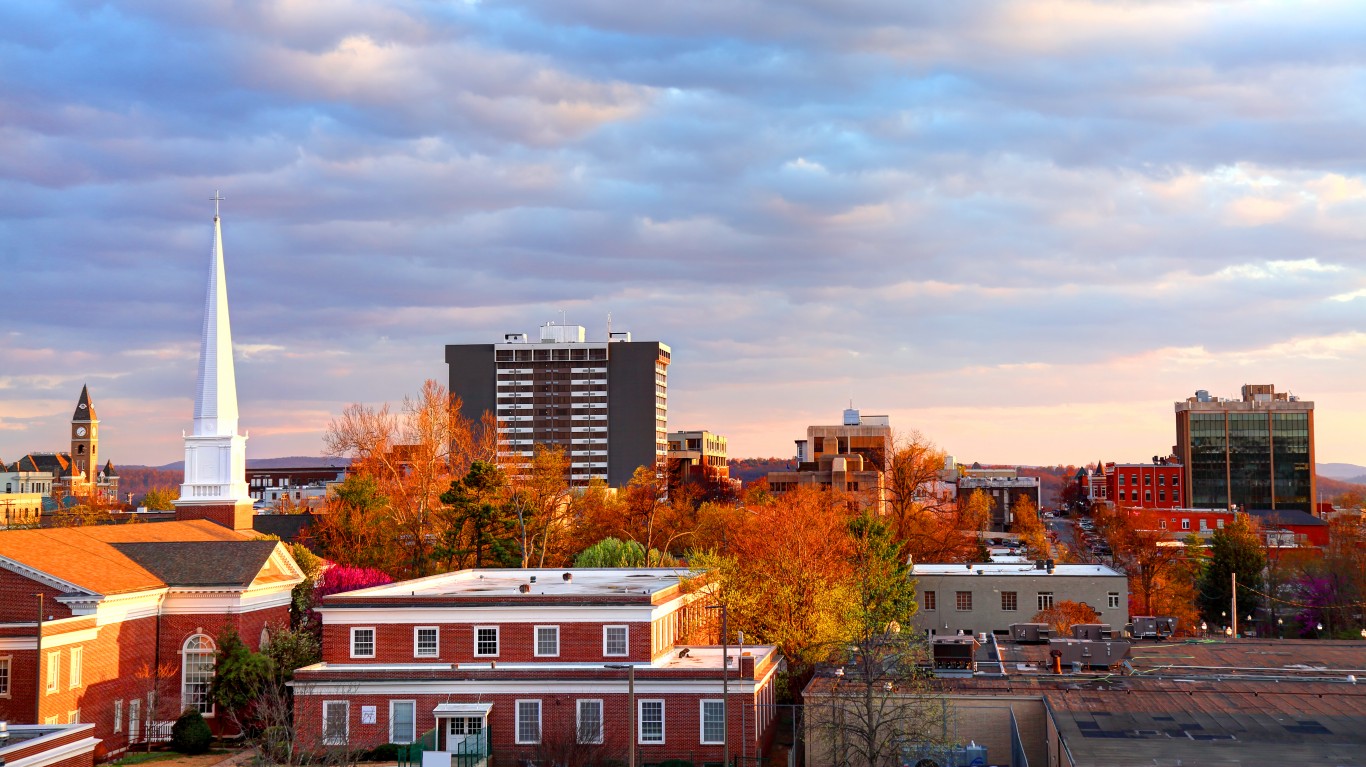
49. Arkansas
> Life expectancy at age 65: 82.9 years (tied – 6th lowest)
> 65 and older poverty rate: 10.2% (tied – 11th highest)
> 65 and older pop. with a disability: 41.9% (2nd highest)
> Median income for 65 and older households: $37,762 (4th lowest)
> Population 65 and older: 507,676 (16.8% – 22nd highest)
Access to quality public transportation can help retirement-age residents maintain their independence, particularly as declining health or eyesight means some are no longer able to drive. Using workers taking public transportation as a proxy for the state infrastructure, Arkansas’s public transportation network is one of the most limited in the country. Less than 0.5% of workers in the state use public transportation to go to work, compared to some 5% of workers nationwide.
Like many of the states that rank as worse places to grow old, Arkansas ranks especially poorly in measures of senior health, including life expectancy at 65 and older Americans with a disability.

48. Mississippi
> Life expectancy at age 65: 82.6 years (3rd lowest)
> 65 and older poverty rate: 12.4% (tied – 2nd highest)
> 65 and older pop. with a disability: 39.6% (6th highest)
> Median income for 65 and older households: $36,415 (3rd lowest)
> Population 65 and older: 474,423 (15.9% – 19th lowest)
Like many of its neighbors in the South, Mississippi ranks as one of the worst states for older Americans, largely due to measures of retirement-age income, education, and health. People who are 65 today are expected to live to the age of 82.6, which is the third lowest life expectancy in the U.S. and almost two years lower than the national life expectancy at 65. Mississippi is also one of a minority of states where more than one in four seniors do not have a personal doctor or health care provider.

47. Louisiana
> Life expectancy at age 65: 83.1 years (tied – 8th lowest)
> 65 and older poverty rate: 12.4% (tied – 2nd highest)
> 65 and older pop. with a disability: 38.0% (8th highest)
> Median income for 65 and older households: $36,345 (2nd lowest)
> Population 65 and older: 720,610 (15.5% – 10th lowest)
Retirement-age Americans living in Louisiana are more likely to be struggling financially than those living in nearly every other state. The typical 65 and older household in the state earns just $36,345 a year, well below the national median income of retirement-age households of $44,992. Similarly, 12.4% of the state’s 65 and older population lives below the poverty line, the second highest elderly poverty rate among states.
The overall quality of life in Louisiana is also reduced by the state’s high crime rates. Both the state’s property and violent crime rates rank among the highest in the country.
[in-text-ad-2]

46. Alabama
> Life expectancy at age 65: 82.7 years (4th lowest)
> 65 and older poverty rate: 10.3% (tied – 9th highest)
> 65 and older pop. with a disability: 39.0% (7th highest)
> Median income for 65 and older households: $37,977 (5th lowest)
> Population 65 and older: 829,663 (17.0% – 19th highest)
Alabama ranks as one of the worst states for older Americans in several different categories in our index, including health, education, and environment. For example, the state appears to have one of the least extensive public transportation networks of any state. Seniors are vulnerable to violence and are less likely to recover, and Alabama has one of the highest violent crime rates in the country.

45. Kentucky
> Life expectancy at age 65: 82.5 years (tied – the lowest)
> 65 and older poverty rate: 10.2% (tied – 11th highest)
> 65 and older pop. with a disability: 39.7% (5th highest)
> Median income for 65 and older households: $38,254 (6th lowest)
> Population 65 and older: 731,392 (16.4% – 24th lowest)
Kentucky’s older residents are among the least likely to be healthy compared to those in other states. There were over 4,700 deaths per 100,000 people 65 and older in the state in 2018, the second highest rate of any state. The state is also tied with West Virginia for having the second lowest life expectancy at 65 of any state. Just under 40% of state retirement-age residents have some form of disability, the fifth highest share of any state.
[in-text-ad]

44. Tennessee
> Life expectancy at age 65: 83.1 years (tied – 8th lowest)
> 65 and older poverty rate: 9.2% (19th highest)
> 65 and older pop. with a disability: 37.4% (tied – 9th highest)
> Median income for 65 and older households: $39,933 (7th lowest)
> Population 65 and older: 1.1 million (16.3% – 23rd lowest)
For many senior citizens with deteriorating vision and reaction time, driving is not an option. This is often why older Americans may choose to live in areas with reliable public transportation. In Tennessee, however, public transit may be harder to rely on as just 1.3% of workers commute using public transportation or walk, well below the 7.5% share of commuters nationwide and likely indicative of a poor transit system.
The overall quality of life in Tennessee is also reduced by high crime rates. The concentration of violent crimes in the state is the third highest in the country, and the property crime rate ranks 10th highest among states.

43. Oklahoma
> Life expectancy at age 65: 82.9 years (tied – 6th lowest)
> 65 and older poverty rate: 8.7% (tied – 25th highest)
> 65 and older pop. with a disability: 42.6% (the highest)
> Median income for 65 and older households: $40,928 (10th lowest)
> Population 65 and older: 619,601 (15.7% – 15th lowest)
Based on the measures used in the index, Oklahoma has the least healthy retirement-age population in the country. Of all residents in the state who are at least 65, a nation-highest 42.6% have some form of disability, compared to a national share of 33.9%. The state also has the highest annual mortality rate for seniors, with 4,715 deaths per 100,000 people 65 and over, nearly 700 deaths above the national rate.
The state also appears to have a relatively weak public transportation network — an important factor in independence for people 65 and older.

42. Nevada
> Life expectancy at age 65: 83.9 years (tied – 18th lowest)
> 65 and older poverty rate: 9.8% (15th highest)
> 65 and older pop. with a disability: 33.6% (tied – 25th highest)
> Median income for 65 and older households: $46,406 (16th highest)
> Population 65 and older: 475,120 (15.7% – 13th lowest)
Nevada’s ranks as the second worst state in measures of environment and access in our index. Notably, the state has the smallest concentration of social associations per person 65 and over, as well as one of the highest violent crime rates in the country. Additionally, more than 30% of Nevada’s seniors do not have a doctor or personal health care professional.
[in-text-ad-2]

41. Texas
> Life expectancy at age 65: 84.2 years (tied – 24th lowest)
> 65 and older poverty rate: 11.1% (6th highest)
> 65 and older pop. with a disability: 36.4% (tied – 12th highest)
> Median income for 65 and older households: $44,319 (22nd highest)
> Population 65 and older: 3.6 million (12.5% – 3rd lowest)
Retirement-age Americans are more likely to be struggling financially in Texas than in the vast majority of other states. Of the 65 and older population in Texas, 11.1% live below the poverty line, a larger share than in all but five other states.
Senior citizens in Texas are also more likely to have to rely on a personal vehicle for transportation than most older Americans. Just 2.8% of commuters in the state use public transportation or walk, well below the 7.5% share of commuters nationwide.

40. Missouri
> Life expectancy at age 65: 83.6 years (14th lowest)
> 65 and older poverty rate: 8.2% (19th lowest)
> 65 and older pop. with a disability: 36.4% (tied – 12th highest)
> Median income for 65 and older households: $41,038 (11th lowest)
> Population 65 and older: 1.0 million (16.9% – 21st highest)
Missouri ranks among the worst states for seniors in measures of income and health. The state has a below average life expectancy at 65 and an above average share of retirement-age residents with a disability. The state also has relatively high property and violent crime rates, which reduces overall quality of life.
[in-text-ad]

39. New Mexico
> Life expectancy at age 65: 84.7 years (tied – 13th highest)
> 65 and older poverty rate: 13.3% (the highest)
> 65 and older pop. with a disability: 40.0% (4th highest)
> Median income for 65 and older households: $39,989 (8th lowest)
> Population 65 and older: 368,480 (17.6% – 12th highest)
In New Mexico, only 42.2% of 65 and older households have retirement income in the form of a 401(k), pension, or similar source, lower than the nationwide share of 48.5% of retirement-age households. The smaller share of older residents with a steady income likely contributes to the state’s high poverty rate among the 65 and older population. A staggering 13.3% of retirement-age New Mexico residents live below the poverty line, the highest rate of any state and well above the 9.4% national rate.
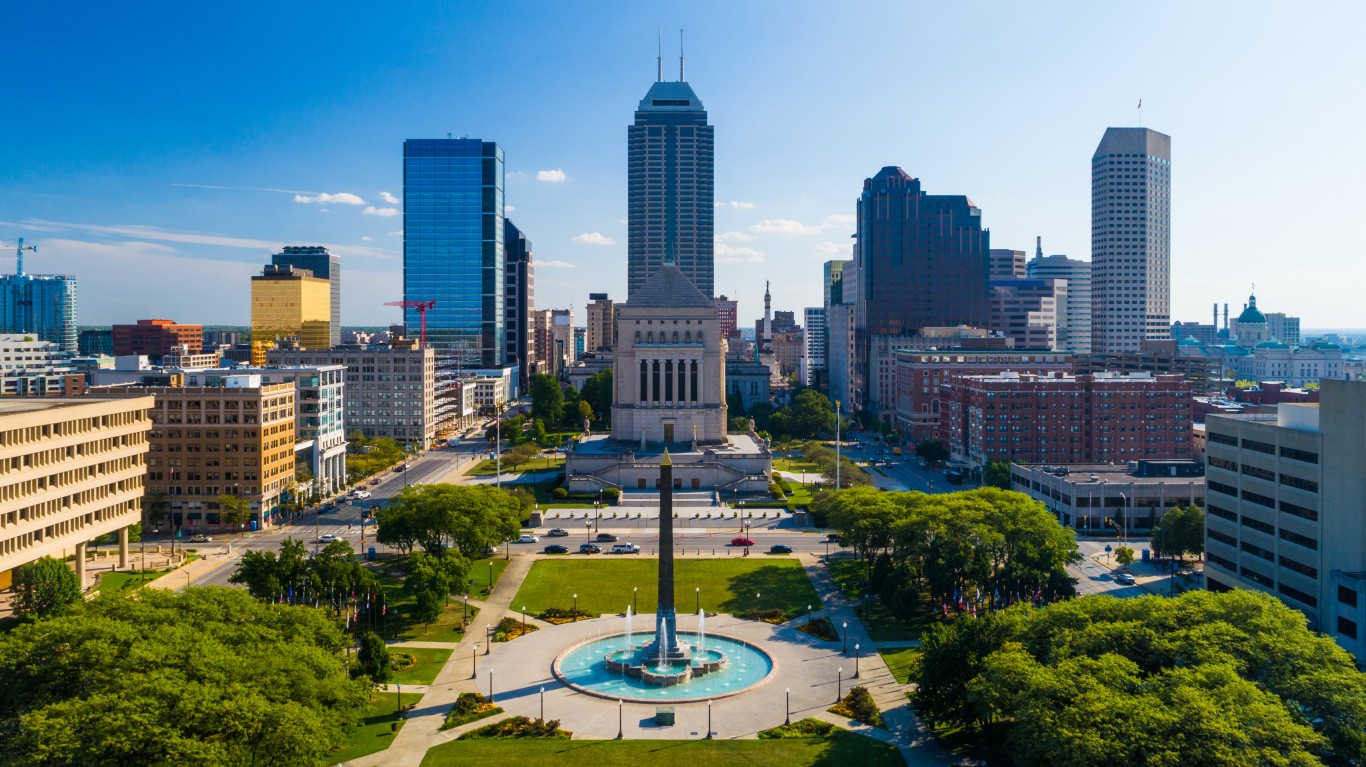
38. Indiana
> Life expectancy at age 65: 83.4 years (11th lowest)
> 65 and older poverty rate: 7.9% (tied – 16th lowest)
> 65 and older pop. with a disability: 34.9% (15th highest)
> Median income for 65 and older households: $41,342 (13th lowest)
> Population 65 and older: 1.1 million (15.7% – 14th lowest)
For Indiana’s retirement-age population who can no longer drive, getting around is likely more difficult than it is for senior people in much of the rest of the country. Just 2.8% of commuters in the state use public transit, well below the 7.5% national average. Low usage rates can be indicative of inaccessible, unreliable, or underdeveloped public transportation infrastructure.
Life expectancy for those at age 65 in the state is also lower than average. Life expectancy for those turning 65 years old in Indiana is an additional 18.4 years to 83.4 years, lower than in most states and a year below the national average.

37. Ohio
> Life expectancy at age 65: 83.2 years (9th lowest)
> 65 and older poverty rate: 8.6% (tied – 24th lowest)
> 65 and older pop. with a disability: 34.1% (tied – 18th highest)
> Median income for 65 and older households: $41,406 (15th lowest)
> Population 65 and older: 2.0 million (17.1% – 17th highest)
Ohio compares relatively well to other states in terms of senior income. Close to 55% of state residents 65 or older have some form of retirement income in the form of a 401(k), pension, or similar source, which is well above the 48.5% share nationwide, and the state’s poverty rate among retirement-age residents is lower than the national rate.
However, Ohio’s older residents are more likely than most to be in poor health. The state has one of the highest annual mortality rates among residents 65 or older, and Ohio ranks among the 10 worst states in life expectancy at 65.
[in-text-ad-2]

36. South Carolina
> Life expectancy at age 65: 83.3 years (10th lowest)
> 65 and older poverty rate: 9.5% (16th highest)
> 65 and older pop. with a disability: 34.3% (tied – 16th highest)
> Median income for 65 and older households: $42,161 (17th lowest)
> Population 65 and older: 899,754 (17.7% – 10th highest)
For South Carolina residents who are 65 years old, average life expectancy is an additional 18.3 years to 83.3, more than a year below the national average of 84.4. The state’s retirement-age population is also more likely to be suffering from a disability than those in most other states.
Still, likely due in part to the state’s warm climate, South Carolina is a popular place for older Americans. The retirement-age population of nearly 900,000 accounts for 17.7% of the state’s total population, a larger than average share. Additionally, 2.2% of older adults in the state moved there in the last year, a larger share than in all but a handful of other states.

35. Georgia
> Life expectancy at age 65: 83.5 years (tied – 13th lowest)
> 65 and older poverty rate: 10.2% (tied – 11th highest)
> 65 and older pop. with a disability: 34.0% (tied – 20th highest)
> Median income for 65 and older households: $42,781 (22nd lowest)
> Population 65 and older: 1.5 million (13.8% – 4th lowest)
For older residents, Georgia compares favorably to many other states in the South, but it still ranks poorly relative to national averages. The state ranks relatively poorly in measures of senior health, with a below-average life expectancy at 65. It also has one of the highest shares of retirement-age residents who do not have a personal doctor or health care provider.
The state has one of the smaller senior populations in the country relative to the general population — just 13.8% of residents are 65 or older.
[in-text-ad]

34. Idaho
> Life expectancy at age 65: 84.4 years (tied – 23rd highest)
> 65 and older poverty rate: 8.6% (tied – 24th lowest)
> 65 and older pop. with a disability: 35.3% (14th highest)
> Median income for 65 and older households: $42,678 (20th lowest)
> Population 65 and older: 279,441 (15.9% – 20th lowest)
Remaining socially engaged through retirement can greatly improve quality of life. In Idaho, however, that may be more difficult than in other states. There are only 45.5 social organizations — such as clubs, bowling centers, golf clubs, fitness centers, sports organizations, or religious organizations — for every 100,000 65 and older residents in Idaho, well below the national concentration of 58.0 per 100,000.
Still, older Idaho residents are more likely than most older Americans to own a home and maintain independence. The homeownership rate among 65 and older Idaho residents is 83.6% — higher than in all but a handful of other states.
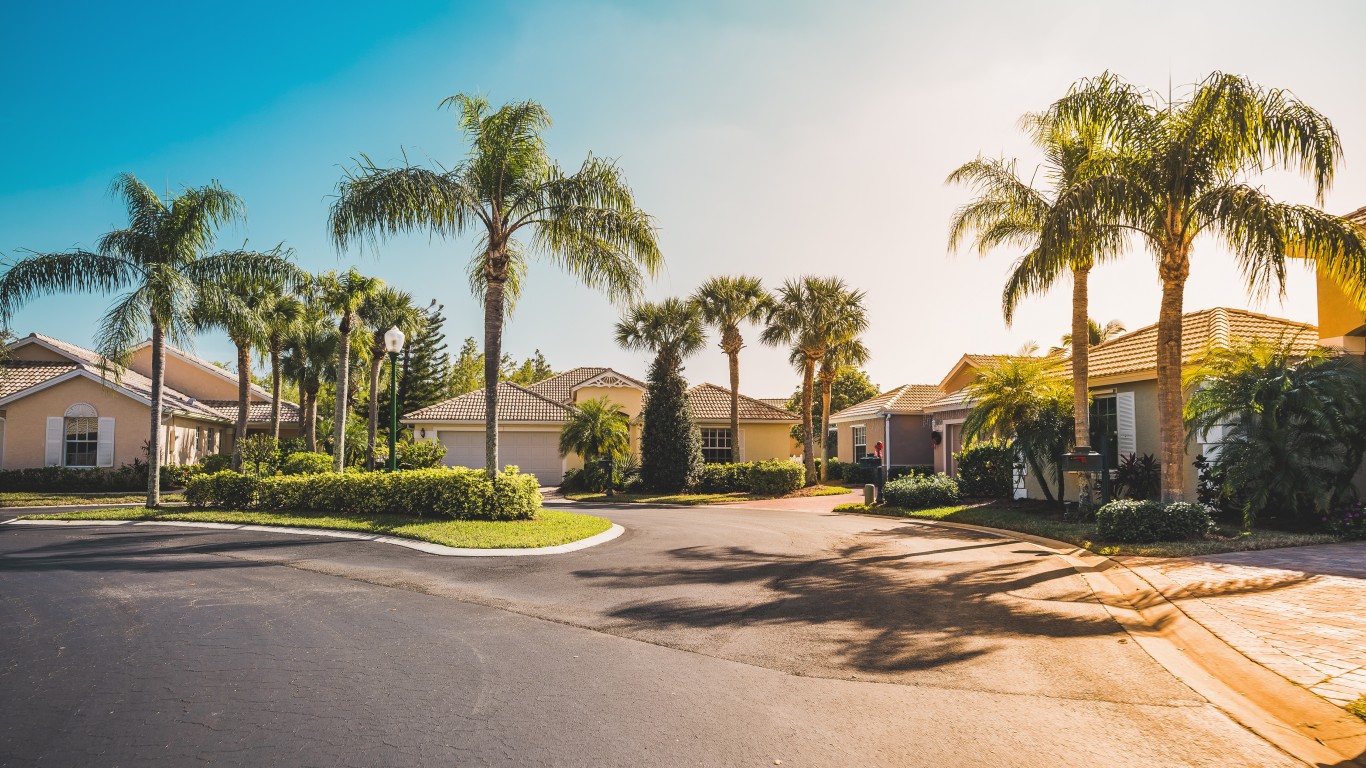
33. Florida
> Life expectancy at age 65: 85.3 years (tied – 5th highest)
> 65 and older poverty rate: 10.6% (7th highest)
> 65 and older pop. with a disability: 32.8% (18th lowest)
> Median income for 65 and older households: $43,804 (24th highest)
> Population 65 and older: 4.4 million (20.5% – 2nd highest)
Florida is known as a state that many senior citizens choose to move to in retirement. Just over 20% of state residents are 65 and older, the second highest share in the country after Maine. Still, while Florida’s older population is more likely to find people their own age, they are also more likely to face financial difficulties. A relatively small share of the state’s 65 and over population have some form of retirement income, less than in most other states, and the state’s poverty rate among 65 and older residents of 10.6% is the seventh highest among states.

32. Michigan
> Life expectancy at age 65: 83.9 years (tied – 18th lowest)
> 65 and older poverty rate: 9.0% (tied – 22nd highest)
> 65 and older pop. with a disability: 34.1% (tied – 18th highest)
> Median income for 65 and older households: $42,816 (23rd lowest)
> Population 65 and older: 1.7 million (17.2% – 15th highest)
In the senior income segment of our index, Michigan ranks favorably compared to most states. About 57% of state retirement-age households have some form of retirement income, the second highest share of any state. Michigan also has a below average senior poverty rate.
In measures of environment and access for older residents, the state does not perform as well. The state has a relatively low concentration of social associations per 65 and over resident and relatively few hospitals per capita.
[in-text-ad-2]

31. North Dakota
> Life expectancy at age 65: 84.5 years (tied – 17th highest)
> 65 and older poverty rate: 10.3% (tied – 9th highest)
> 65 and older pop. with a disability: 33.4% (22nd lowest)
> Median income for 65 and older households: $44,824 (21st highest)
> Population 65 and older: 116,433 (15.3% – 7th lowest)
Just 37.5% of 65 and older households in North Dakota have some have retirement income in the form of a 401(k), pension, or similar source, the smallest share of any state. Likely partially as a result, the state’s 10.3% elderly poverty rate is higher than average.
Still, quality of life for the state senior citizens is bolstered by the highest concentration of hospitals and the highest concentration of social associations — such as clubs, bowling centers, golf clubs, fitness centers, sports organizations, or religious organizations — of any state.

30. North Carolina
> Life expectancy at age 65: 83.9 years (tied – 18th lowest)
> 65 and older poverty rate: 8.7% (tied – 25th highest)
> 65 and older pop. with a disability: 34.3% (tied – 16th highest)
> Median income for 65 and older households: $41,169 (12th lowest)
> Population 65 and older: 1.7 million (16.3% – 22nd lowest)
Senior citizens in North Carolina are slightly less likely to be struggling financially than those in much of the rest of the country. The poverty rate among the state’s 65 and older population is 8.7%, compared to the 9.4% national 65 and over poverty rate.
Disadvantages for the state’s older population include inaccessible, unreliable, or underdeveloped public transportation infrastructure, as evidenced by low usage rates. Just 2.8% of commuters in the state use public transit, well below the national average of 7.5%.
[in-text-ad]
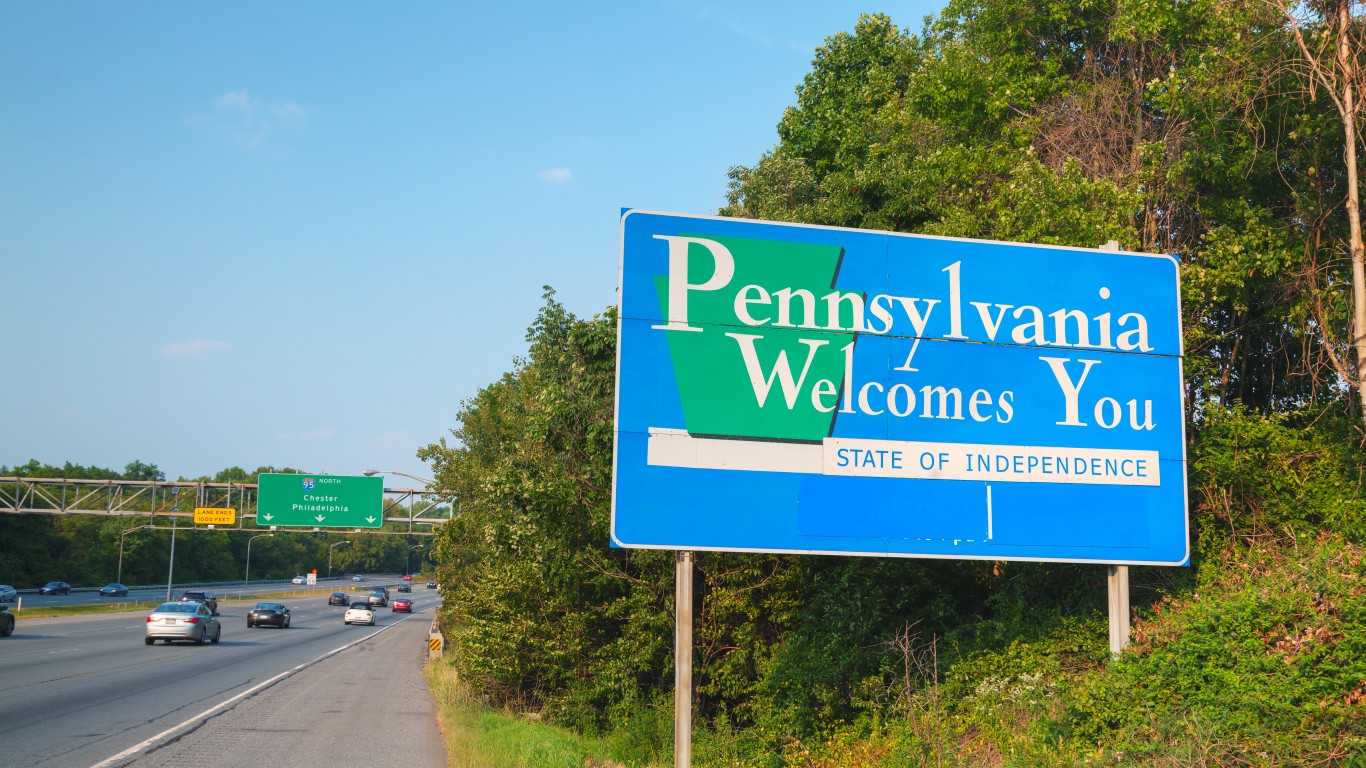
29. Pennsylvania
> Life expectancy at age 65: 84.0 years (tied – 20th lowest)
> 65 and older poverty rate: 8.3% (20th lowest)
> 65 and older pop. with a disability: 33.2% (21st lowest)
> Median income for 65 and older households: $41,762 (16th lowest)
> Population 65 and older: 2.3 million (18.2% – 8th highest)
There are more than 2.3 million retirement-age Pennsylvania residents, more than in all but four other states. The state’s older residents benefit from a higher than average concentration of hospitals as well as social associations, such as clubs, bowling centers, golf clubs, fitness centers, sports organizations, or religious organizations.
Still, just 15.1% of older Pennsylvania residents have their own doctor or health care provider, which can improve the quality of care received and can be critical in old age. Life expectancy at age 65 in Pennsylvania is also shorter than it is in most other states.

28. Arizona
> Life expectancy at age 65: 85.1 years (8th highest)
> 65 and older poverty rate: 8.6% (tied – 24th lowest)
> 65 and older pop. with a disability: 33.6% (tied – 25th highest)
> Median income for 65 and older households: $46,152 (17th highest)
> Population 65 and older: 1.3 million (17.6% – 13th highest)
Financial security can be critical to quality of life, and Arizona’s older population is more likely than most 65 and older Americans to have retirement income in the form of a 401(k), pension, or similar source and less likely to live below the poverty line.
While the state may be an attractive option for many older Americans looking to retire in a warmer climate, remaining social into old age may be harder in Arizona than most other states. The state has a relatively low concentration of social associations like clubs, bowling centers, golf clubs, fitness centers, sports organizations, or religious organizations just 31.6 per 100,000 65 and older residents, well below the national concentration of 58.0 per 100,000.

27. Wisconsin
> Life expectancy at age 65: 84.7 years (tied – 13th highest)
> 65 and older poverty rate: 7.9% (tied – 16th lowest)
> 65 and older pop. with a disability: 30.6% (4th lowest)
> Median income for 65 and older households: $41,362 (14th lowest)
> Population 65 and older: 986,483 (17.0% – 20th highest)
Wisconsin’s seniors tend to have relatively low incomes. The median annual household income for 65 and older households is $41,362, which is roughly $3,600 below the comparable national median income. However, a relatively small 7.9% of 65 and older residents live in poverty in the state, compared to the comparable national poverty rate of 9.4%.
Just 30.6% of retirement-age residents in the state have some form of disability, the fourth smallest share among states.
[in-text-ad-2]

26. Illinois
> Life expectancy at age 65: 84.5 years (tied – 17th highest)
> 65 and older poverty rate: 8.8% (24th highest)
> 65 and older pop. with a disability: 32.0% (16th lowest)
> Median income for 65 and older households: $44,955 (19th highest)
> Population 65 and older: 2.0 million (15.6% – 12th lowest)
Access to quality public transportation can help seniors maintain their independence, particularly as declining health or eyesight means some are no longer able to drive. Using the share of workers who commute by taking public transportation as a proxy for the quality and reach of the state’s public transit, Illinois has one of the widest reaching public transportation networks of any state. In several of the categories considered for this index, including education and environment and access, the state ranks approximately in the middle of all states.

25. Iowa
> Life expectancy at age 65: 84.5 years (tied – 17th highest)
> 65 and older poverty rate: 7.1% (6th lowest)
> 65 and older pop. with a disability: 31.1% (tied – 9th lowest)
> Median income for 65 and older households: $42,995 (25th highest)
> Population 65 and older: 537,818 (17.0% – 18th highest)
Remaining socially engaged through retirement can greatly improve quality of life — and in Iowa, doing so is likely easier than in other states. There are 84.5 social organizations — such as clubs, bowling centers, golf clubs, fitness centers, sports organizations, or religious organizations — for every 100,000 65 and older residents in Iowa, the fifth highest concentration among states.
[in-text-ad]

24. Rhode Island
> Life expectancy at age 65: 84.6 years (tied – 15th highest)
> 65 and older poverty rate: 11.2% (5th highest)
> 65 and older pop. with a disability: 32.4% (17th lowest)
> Median income for 65 and older households: $42,424 (19th lowest)
> Population 65 and older: 182,645 (17.3% – 14th highest)
Rhode Island ranks relatively poorly in the income category of our index gauging the best states for older Americans. With 11.2% of residents 65 and over living in poverty, the state has one of the highest senior poverty rates of any state.
However, in other categories, such as health and education, it ranks better than the majority of states for older Americans.

23. California
> Life expectancy at age 65: 85.7 years (2nd highest)
> 65 and older poverty rate: 10.5% (8th highest)
> 65 and older pop. with a disability: 33.5% (23rd lowest)
> Median income for 65 and older households: $54,272 (6th highest)
> Population 65 and older: 5.7 million (14.3% – 6th lowest)
Life expectancy at age 65 in California is an additional 20.7 years to 85.7 years, the second highest among states and higher than the additional 19.4 years national average. Life expectancy in the state is high despite a lower than average share of older state residents who have their own doctor or health care provider and a lower than average concentration of hospitals.
Additionally, while the median income among retirement-age households in California of $54,272 is higher than in most states. Also, the state’s high cost of living means a dollar does not go as far. Goods and services in California are about 15% more expensive on average than they are nationwide.

22. Nebraska
> Life expectancy at age 65: 84.4 years (tied – 23rd highest)
> 65 and older poverty rate: 7.6% (tied – 12th lowest)
> 65 and older pop. with a disability: 33.7% (24th highest)
> Median income for 65 and older households: $42,851 (24th lowest)
> Population 65 and older: 303,998 (15.8% – 16th lowest)
Only 41.3% of 65 and older households in Nebraska have some form of retirement income, the third lowest share of any state. Still, Nebraska’s 65 and older poverty rate of 7.6% is lower than most states and the 9.4% national average. The greater financial security among the state’s older population is likely due in part to a low cost of living. Good and services are about 10% less expensive on average in Nebraska than they are nationwide.
[in-text-ad-2]

21. Maine
> Life expectancy at age 65: 83.7 years (15th lowest)
> 65 and older poverty rate: 9.1% (tied – 20th highest)
> 65 and older pop. with a disability: 33.8% (23rd highest)
> Median income for 65 and older households: $40,435 (9th lowest)
> Population 65 and older: 276,069 (20.6% – the highest)
Maine has the lowest violent crime rate of any state in the U.S. and the fourth lowest property crime rate, which improves overall quality of life. The state also has one of the lowest shares of 65 and older residents who do not have a doctor or health care provider, at 14.8% compared to the national share of 22.8%.
However, Maine compares poorly to most states in the senior income section of our index. Just under 45% of retirement-age households in the state have some form of retirement income such as a pension or 401(k), tied with Oklahoma as the ninth smallest share among states.

20. Wyoming
> Life expectancy at age 65: 84.2 years (tied – 24th lowest)
> 65 and older poverty rate: 7.3% (tied – 9th lowest)
> 65 and older pop. with a disability: 33.9% (22nd highest)
> Median income for 65 and older households: $44,870 (20th highest)
> Population 65 and older: 96,557 (16.7% – 23rd highest)
In Wyoming, almost one-third of 65 and older residents do not have a personal doctor or health care provider, the largest share of any state after Alaska. However, the state ranks relatively well in other measures of our index, notably the category that measures environment and access. The state has one of the higher concentrations of social associations per 65 and older citizens.
[in-text-ad]

19. South Dakota
> Life expectancy at age 65: 84.4 years (tied – 23rd highest)
> 65 and older poverty rate: 9.0% (tied – 22nd highest)
> 65 and older pop. with a disability: 31.2% (tied – 11th lowest)
> Median income for 65 and older households: $42,361 (18th lowest)
> Population 65 and older: 146,358 (16.6% – 24th highest)
Access to public transportation can be important for older Americans who are unable to drive and rely on transit for mobility and independence. Compared to other states, South Dakota’s public transportation system is relatively small. Just 0.2% of workers in the state take public transportation or walk to work.
The state ranks well, however, in some other measures of quality of life for seniors. For example, the state has the second highest concentration of social organizations — such as clubs, bowling centers, golf clubs, fitness centers, sports organizations, or religious organizations — per 65 and older resident.

18. Kansas
> Life expectancy at age 65: 84.0 years (tied – 20th lowest)
> 65 and older poverty rate: 8.0% (tied – 18th lowest)
> 65 and older pop. with a disability: 36.5% (11th highest)
> Median income for 65 and older households: $42,989 (25th lowest)
> Population 65 and older: 462,191 (15.9% – 18th lowest)
High crime rates. There were 439.0 violent crimes per 100,000 people in the state in 2018 and 2,633.9 property crimes per 100,000 — each higher than the national averages of 380.6 per 100,000 and 2,199.5 per 100,000, respectively.
Still, by several measures, senior citizens in the state are doing better than most of their counterparts nationwide. For example, just 8.0% of Kansas residents 65 and older live below the poverty line compared to 9.4% of retirement-age Americans nationwide.

17. New York
> Life expectancy at age 65: 85.6 years (3rd highest)
> 65 and older poverty rate: 11.8% (4th highest)
> 65 and older pop. with a disability: 31.5% (12th lowest)
> Median income for 65 and older households: $45,302 (18th highest)
> Population 65 and older: 3.2 million (16.4% – 25th lowest)
Access to quality public transportation can help older Americans maintain their independence, particularly as declining health or eyesight means some are no longer able to drive. Using the share of workers who take public transportation as a proxy for the quality and reach of the state’s transit system, New York has the widest reaching public transportation networks of any state — with 28% of commuters statewide relying on it.
By other measures, senior citizens in New York are at a disadvantage. For example, 11.8% of the state population 65 and older lives below the poverty line, a larger share than in all but three states.
[in-text-ad-2]

16. Montana
> Life expectancy at age 65: 83.5 years (tied – 13th lowest)
> 65 and older poverty rate: 9.4% (17th highest)
> 65 and older pop. with a disability: 31.9% (tied – 15th lowest)
> Median income for 65 and older households: $42,745 (21st lowest)
> Population 65 and older: 200,239 (18.8% – 5th highest)
Retirement-age adults in Montana are less likely to have a personal doctor or health care provider than most Americans 65 and older. Still, obtaining health care when necessary may not be as difficult for older Montana residents as the state has a far higher per capita concentration of hospitals than the national average.
Remaining socially engaged through retirement can greatly improve quality of life, and in Montana, doing so is likely easier than in other states. There are 74.9 social organizations — such as clubs, bowling centers, golf clubs, fitness centers, sports organizations, or religious organizations — for every 100,000 65 and older residents in Montana, compared to 58.0 per 100,000 nationwide.

15. Oregon
> Life expectancy at age 65: 84.5 years (tied – 17th highest)
> 65 and older poverty rate: 7.9% (tied – 16th lowest)
> 65 and older pop. with a disability: 33.6% (tied – 25th highest)
> Median income for 65 and older households: $47,314 (14th highest)
> Population 65 and older: 739,611 (17.6% – 11th highest)
Older Oregon residents are more likely to be financially secure than the typical retirement-age American. The median income among 65 and older households in the state is $47,314, slightly higher than the comparable national median of $44,992. Additionally, the poverty rate among Oregon’s 65 and older population is just 7.9%, lower than the 9.4% poverty rate among elderly Americans nationwide.
[in-text-ad]

14. New Jersey
> Life expectancy at age 65: 85.3 years (5th highest)
> 65 and older poverty rate: 8.0% (tied – 18th lowest)
> 65 and older pop. with a disability: 30.0% (2nd lowest)
> Median income for 65 and older households: $53,637 (8th highest)
> Population 65 and older: 1.4 million (16.1% – 21st lowest)
Despite a far higher than average cost of living, New Jersey’s retirement-age population is more likely to be financially secure than most older Americans. The typical retirement-age household has an annual income of $53,637, well above the $44,992 comparable national median. Additionally, just 8.0% of New Jersey residents 65 and older live below the poverty line compared to the 9.4% national poverty rate among older Americans.
Life expectancy is also higher than average in the Garden State. For New Jersey residents who are 65 years old, life expectancy is 85.3 years, nearly a year longer than the national average life expectancy at 65.

13. Minnesota
> Life expectancy at age 65: 85.3 years (tied – 5th highest)
> 65 and older poverty rate: 7.6% (tied – 12th lowest)
> 65 and older pop. with a disability: 30.9% (tied – 7th lowest)
> Median income for 65 and older households: $47,054 (15th highest)
> Population 65 and older: 888,634 (15.8% – 17th lowest)
Minnesota’s eldery population ranks among the healthiest in the United States. Life expectancy at age 65 in the state is an additional 20.3 years to 85.3 years, nearly a year longer than the national average. The state’s elderly population is also far less likely to be struggling financially than most older Americans as just 7.6% of retirement-age Minnesota residents live below the poverty line, well below the comparable national rate of 9.4%.
Quality of life in Minnesota is also boosted by low crime rates. Both the state’s violent crime rate and property crime rate are lower than the comparable national averages.

12. Alaska
> Life expectancy at age 65: 84.1 years (21st lowest)
> 65 and older poverty rate: 6.7% (5th lowest)
> 65 and older pop. with a disability: 37.4% (tied – 9th highest)
> Median income for 65 and older households: $59,339 (3rd highest)
> Population 65 and older: 88,000 (11.9% – 2nd lowest)
Incomes are higher for retirement-age households in Alaska than they are in nearly every other state. The median household income of 65 and older households in the state is $59,339, about $14,000 more than the median nationwide. Additionally, Alaska’s 65 and over poverty rate of just 6.7% is the fifth lowest among states.
Remaining socially engaged through retirement can greatly improve quality of life — and in Alaska, doing so is likely easier than in other states. There are 95.5 social organizations — such as clubs, bowling centers, golf clubs, fitness centers, sports organizations, or religious organizations — for every 100,000 65 and older residents, compared to 58.0 per 100,000 nationwide.
[in-text-ad-2]

11. Delaware
> Life expectancy at age 65: 84.4 years (tied – 23rd highest)
> 65 and older poverty rate: 6.1% (tied – 3rd lowest)
> 65 and older pop. with a disability: 30.9% (tied – 7th lowest)
> Median income for 65 and older households: $54,744 (4th highest)
> Population 65 and older: 180,756 (18.7% – 6th highest)
Like many of the states ranking highly on this list, Delaware’s elderly population is more likely to be financially secure than most older Americans. The typical 65 and older household in Delaware earns $54,744 a year, more than in all but three other states. Additionally, just 6.1% of the state’s 65 and older population lives below the poverty line, well below the 9.4% national poverty rate for older Americans. Life expectancy for those who are 65 in the state is an additional 19.4 years to 84.4, in line with the national average life expectancy at 65.

10. Virginia
> Life expectancy at age 65: 84.5 years (tied – 17th highest)
> 65 and older poverty rate: 8.4% (21st lowest)
> 65 and older pop. with a disability: 33.1% (20th lowest)
> Median income for 65 and older households: $51,401 (11th highest)
> Population 65 and older: 1.3 million (15.5% – 11th lowest)
Virginia’s high ranking is due in part to its high quality of life, bolstered by low crime rates. Both Virginia’s violent and property crime rates fall well below the comparable national averages.
Remaining socially engaged through retirement can greatly improve quality of life — and in Virginia, doing so is likely easier than in other states. There are 73.1 social organizations — such as clubs, bowling centers, golf clubs, fitness centers, sports organizations, or religious organizations — for every 100,000 65 and older residents, compared to 58.0 per 100,000 nationwide.
[in-text-ad]

9. Vermont
> Life expectancy at age 65: 84.8 years (12th highest)
> 65 and older poverty rate: 9.3% (18th highest)
> 65 and older pop. with a disability: 31.9% (tied – 15th lowest)
> Median income for 65 and older households: $44,302 (23rd highest)
> Population 65 and older: 123,875 (19.8% – 4th highest)
In the income component of our index, Vermont ranks poorly compared to most states, in part due to the fact that only 41.9% of senior households have some form of retirement income like a pension or 401(k), the fourth lowest share among states.
However, life for older citizens in Vermont is comparably good by many other measures, including access, education, and health. In the state, just 14.3% of 65 and older residents lack a personal doctor or health care provider, the fourth lowest share of any state.

8. Washington
> Life expectancy at age 65: 84.9 years (tied – 10th highest)
> 65 and older poverty rate: 7.2% (7th lowest)
> 65 and older pop. with a disability: 34.0% (tied – 20th highest)
> Median income for 65 and older households: $52,150 (9th highest)
> Population 65 and older: 1.2 million (15.4% – 9th lowest)
For many senior citizens with deteriorating vision and reaction time, driving is not an option. This is often why older Americans may choose to live in areas with reliable public transportation. In Washington, public transit is likely easier to rely on as 10.7% of workers commute using public transportation or by walking, above the 7.5% share of commuters nationwide.
Life expectancy at age 65 in Washington is also higher than average. The typical 65 year old in Washington is expected to live to be 84.9 years old, about half a year above the national average.

7. Massachusetts
> Life expectancy at age 65: 84.9 years (tied – 10th highest)
> 65 and older poverty rate: 9.1% (tied – 20th highest)
> 65 and older pop. with a disability: 31.2% (tied – 11th lowest)
> Median income for 65 and older households: $49,756 (13th highest)
> Population 65 and older: 1.1 million (16.5% – 25th highest)
Massachusetts ranks as one of the best states in the country in measures of senior education and health. A higher than average 35% of the state’s 65 and over residents have a bachelor’s degree, which can be tied to empowerment.
Additionally, the state has among the highest life expectancy at 65. This high life expectancy may be partly related to the fact that only 13.3% of retirement-age residents in the state do not have a personal doctor or health care provider, the lowest share nationwide and significantly lower than the national share of 22.8%.
[in-text-ad-2]

6. Utah
> Life expectancy at age 65: 84.5 years (tied – 17th highest)
> 65 and older poverty rate: 6.1% (tied – 3rd lowest)
> 65 and older pop. with a disability: 32.9% (19th lowest)
> Median income for 65 and older households: $53,670 (7th highest)
> Population 65 and older: 351,297 (11.1% – the lowest)
Utah does not rank quite as well as some of the other best states for older Americans in measures of individual health, but it ranks as one of the best in the education and income categories of our index. It is one of just four states where over 55% of 65 and older households have some form of retirement income like a pension or 401(k) compared to a national share of 48.5%. Also, just 6.1% of Utah’s retirement-age population lives below the poverty level, the third smallest share of any state.

5. Connecticut
> Life expectancy at age 65: 85.4 years (4th highest)
> 65 and older poverty rate: 7.9% (tied – 16th lowest)
> 65 and older pop. with a disability: 29.4% (the lowest)
> Median income for 65 and older households: $54,629 (5th highest)
> Population 65 and older: 613,147 (17.2% – 16th highest)
Connecticut has one of the healthier senior populations in the country. The state has a relatively high life expectancy at 65. It is also the only state in the country where less than 30% of the retirement-age population has a disability of some kind. The state also has the fifth highest median household income for those 65 and and older at $54,629.
[in-text-ad]

4. New Hampshire
> Life expectancy at age 65: 84.2 years (tied – 24th lowest)
> 65 and older poverty rate: 5.5% (the lowest)
> 65 and older pop. with a disability: 30.5% (3rd lowest)
> Median income for 65 and older households: $50,240 (12th highest)
> Population 65 and older: 245,156 (18.1% – 9th highest)
In New Hampshire, just 5.5% of the senior population lives below the poverty line, the smallest share of any state and well below the national poverty rate of 9.4% among Americans 65 and older. New Hampshire also has one of the smallest shares of retirement-age residents with a disability. Just 13.8% of the state’s older residents do not have a personal doctor or health care provider, the second lowest share of any state. New Hampshire also has one of the lowest violent crime rates and the lowest property crime rate in the country.

3. Hawaii
> Life expectancy at age 65: 86.5 years (the highest)
> 65 and older poverty rate: 6.5% (4th lowest)
> 65 and older pop. with a disability: 31.7% (13th lowest)
> Median income for 65 and older households: $65,078 (the highest)
> Population 65 and older: 261,467 (18.4% – 7th highest)
No state ranks better in the health category of our index than Hawaii. People who are 65 in the state can be expected to live to an average age of 86.5 years, longer than any other state and more than two years longer than the national average life expectancy at 65.
While goods and services tend to be very expensive in the state, the typical 65 and older household has an income of $65,078, the highest in the country and over $20,000 higher than the national median income for 65 and over households. Hawaii’s 6.5% poverty rate among retirement-age residents is fourth lowest in the country.
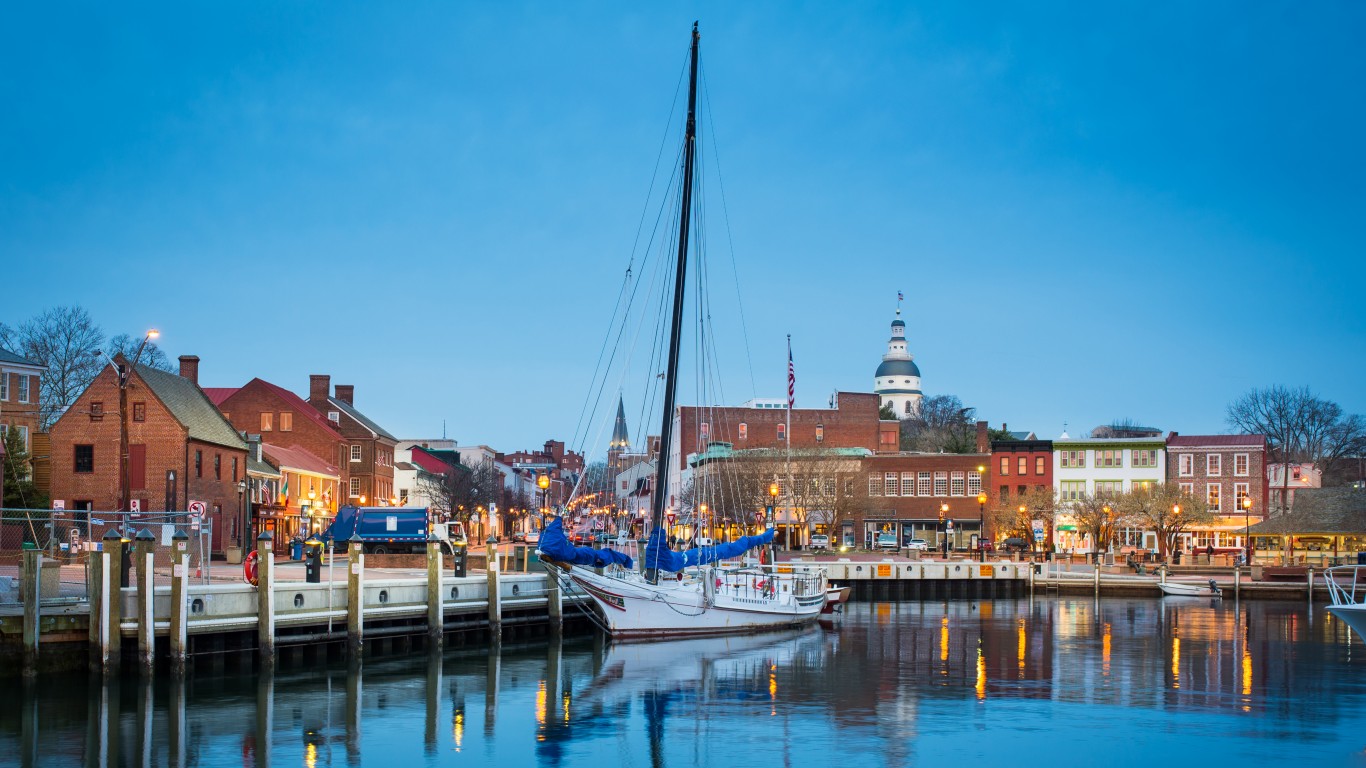
2. Maryland
> Life expectancy at age 65: 84.6 years (tied – 15th highest)
> 65 and older poverty rate: 7.3% (tied – 9th lowest)
> 65 and older pop. with a disability: 30.7% (5th lowest)
> Median income for 65 and older households: $59,536 (2nd highest)
> Population 65 and older: 931,041 (15.4% – 8th lowest)
While Maryland compares unfavorably to most states in the environment and access component of our index, it ranks as one of the best in the education, income, and health components. Notably, the state has the second highest median income among 65 and over households and the second highest bachelor’s degree attainment rate among retirement-age residents.
[in-text-ad-2]

1. Colorado
> Life expectancy at age 65: 85.0 years (9th highest)
> 65 and older poverty rate: 7.4% (10th lowest)
> 65 and older pop. with a disability: 31.1% (tied – 9th lowest)
> Median income for 65 and older households: $51,537 (10th highest)
> Population 65 and older: 807,855 (14.2% – 5th lowest)
Colorado ranks as the best state in the country to live for older Americans. Nearly 40% of the state’s 65 and older population has a bachelor’s degree, the highest share of any state. The state has one of the lowest senior poverty rates. When it comes to the health of the retirement-age population, the state has one of the smallest shares of 65 and over residents with a disability as well as the third lowest annual mortality rate for residents 65 and over.
Methodology
To determine the best and worst states in which to grow old, 24/7 Wall St. created an index of various measures related to the income, health, education, and environment of the elderly population aged 65 and over in all 50 states.
To construct the indices we used the min-max normalization method. For reference, a similar methodology was used in constructing HelpAge International’s Global AgeWatch Index and the United Nations’s Human Development Index.
Income
The percentage of elderly households with supplemental retirement incomes, such as 401(k)s and pensions, as well as poverty rates and median household income for the 65 and over population are one-year estimates from the U.S. Census Bureau’s 2018 American Community Survey. Additionally, as a measure of cost of living, we considered data on regional price parity in 2017 from the Bureau of Economic Analysis.
Health
The percentage of non-institutionalized people 65 and over with a disability came from the ACS. We also included life expectancy after the age of 65 from the Institute for Health Metrics and Evaluation’s Global Health Data Exchange for 2017; the percentage of adults who reported having a personal doctor in 2018 from the Kaiser Family Foundation; and the crude elderly mortality rate per 100,000 people 65 and over in each state in 2018, also from the CDC.
Education
The share of people 65 and over with a bachelor’s degree or higher came from the ACS.
Environment and Accessibility
2018 violent crime rates came from the FBI’s Uniform Crime Report, and the share of workers who walk or use public transportation is from the ACS, which is meant to be a proxy for the reach and quality of public transportation within the state. The concentration of social establishments — civic organizations, bowling centers, golf clubs, fitness centers, sports organizations, religious organizations, political organizations, labor organizations, business organizations, and professional organizations — as well as the number of hospitals in the state came from County Business Patterns and are for 2017. Establishment data was adjusted for the number of residents 65 and over using population data from the ACS.
Are You Ahead, or Behind on Retirement? (sponsor)
If you’re one of the over 4 Million Americans set to retire this year, you may want to pay attention. Many people have worked their whole lives preparing to retire without ever knowing the answer to the most important question: are you ahead, or behind on your retirement goals?
Don’t make the same mistake. It’s an easy question to answer. A quick conversation with a financial advisor can help you unpack your savings, spending, and goals for your money. With SmartAsset’s free tool, you can connect with vetted financial advisors in minutes.
Why wait? Click here to get started today!
Thank you for reading! Have some feedback for us?
Contact the 24/7 Wall St. editorial team.